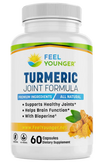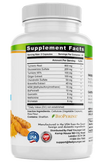Our soothing Turmeric Joint Formula can aid stronger, healthier joints with less pain, stiffness and inflammation.
Turmeric Joint Formula
Our soothing Turmeric Joint Formula can aid stronger, healthier joints with less pain, stiffness and inflammation.
- Product Description
- Supplement Facts
Would you like…
- Stronger, Healthier Joints
- Less Joint Pain and Stiffness
- Reduced inflammation
- Increased Flexibility
- Increased Range of Movement
- Joints that Move Freer and Easier
If so, you may want to try our Turmeric Joint Formula.
The combination of ingredients in this product may also give you the following additional benefits:
- Boosted Immune System
- Antioxidant support
- Improved heart health
- Improved mood
- Improved Digestive Health
- Support in healthy Weight Management
- Optimizing Blood Sugar Levels
- Reduced symptoms of Hayfever
- Indigestion Relief
- Reduced symptoms of Nausea (especially morning sickness)
- Menstrual Pain Relief
Why is it Important to Support Your Joints?
Joints facilitate the movement of bones in your body. Without them, we’d be unable to move freely due to the excruciating pain of bone rubbing on bone.
Inside a joint is a layer of protective cushioning (cartilage) that covers the ends of each bone, and synovial fluid - a thick liquid in the joint.
The cartilage is lubricated by the synovial fluid to reduce friction, allowing the bones to glide over each other freely and without pain.
Having healthy joints will allow you to partake in any movement as small as opening your hand, to walking, running, jumping and playing sports freely and easily, without pain.
What Causes Joint Pain and Deterioration?
Arthritis is a condition that causes inflammation and pain in a joint.
There are many different types of arthritis, with the most common being osteoarthritis and rheumatoid arthritis.
There are many factors that can cause your joints to deteriorate and for a type of arthritis to develop, such as:
- Age
- Gender
- Genetics
- Poor diet
- Previous injuries
- Obesity
- Poor posture
- Medical conditions, including underactive thyroid
- Lack of exercise or not warming up properly
- Stress
- Changes in the weather
Can You Test For Joint Deterioration?
Generally, you will have symptoms in your joints such as pain, tenderness, swelling, inflammation, restricted movement, warm red skin over the affected joint (or it feels extremely cold), weakness, and muscle wasting.
If you experience any of these symptoms, scans such as X-rays and MRI scans can be performed to help diagnose the problem.
The Top 7 Ways to Support and Reduce Pain in Your Joints:
While there are some things we cannot change, such as gender and genetics - here are the top 7 lifestyle changes you can make to help support your joint health:
- Eat a clean organic diet. Processed foods have been linked to increased inflammation [1]. Being overweight or obese puts more pressure on the joints, making them more susceptible to arthritis and injury [2].
- Improve your posture [3] When your posture is not balanced, it puts an excessive strain on certain joints, while others have too little weight on them. This can cause pain in certain joints as the progressive extra pressure on them wears away at the joint.
- Exercise regularly, and always warm up - around 150 minutes a week is recommended [4]. Always wear underlayers to keep your joints warm, especially when it’s cold outside.
- Wear supportive clothing if you need it. If you’ve had a previous injury to a joint, such as a meniscus tear (knee cartilage) be sure to wear a knee support whenever you do strenuous exercise or prolonged periods of exercise [5].
- Reduce your stress. The mind is powerful, and studies have shown the link between psychological pain and joint pain [6].
There are many ways to lower your stress levels, such as meditation. You can also try supplementing with our Serenity Anti-Stress Support or 5 HTP products
- Arrange a thyroid test [7] Lack of optimal thyroid function can cause a reduction in mitochondrial function, meaning less energy for all the body’s systems. It’s been theorized that this explains the strong correlation between joint pain and low thyroid conditions.
- Support your joints with essential nutrients and supportive plant compounds for optimal performance:
Turmeric
Turmeric, or Curcuma Longa as it is scientifically called, is a spice well known for its vibrant yellow color and its use in asian cuisine. Although curcuma longa is native to tropical South Asia, around 133 species worldwide are known to exist [8].
Curcuminoids are compounds that can be found in turmeric and provide it’s famous bright yellow color. The most important of curcuminoids is curcumin, which has been heavily studied for its health benefits [9], mainly due to its powerful anti-inflammatory and antioxidant effects.
Turmeric has been used all over the world in both cooking and medicine for over 4000 years.
From inhaling the fumes of burning turmeric, to drinking its juice and applying pastes - the Ayurvedic medicinal system has been using turmeric to help heal wounds, bruises, skin conditions such as chicken pox, shingles, smallpox and acne and more since around 500 BCE.
The end of the 13th century saw Marco Polo (a venetian merchant, writer and explorer) compare turmeric to saffron for its incredible qualities, color and high price.
Turmeric can offer a whole host of health benefits, such as:
- It is a powerful anti-inflammatory and can help with arthritic conditions and osteoporosis [10]
- It is also a powerful antioxidant and can help to neutralize and block free radicals in the body [11]
- Curcumin can help to improve and boost levels of BDNF proteins (Brain Derived Neurotrophic Factor) [12]
- Curcumin was shown to improve mood [13], focus and memory [14] in older people
- Studies have found curcumin can improve heart health [15]
- Two month supplementation of curcumin suggested improvements in hayfever symptoms [16]
Bioperine. A bioactive compound called piperine can be found in black pepper [17], and Bioperine is a patented piperine extract.
Piperine is important, especially when used in conjunction with turmeric, because it can help to exponentially increase nutrient absorption [18]. This is important because, without adding Piperine, Turmeric is poorly absorbed.
Glucosamine Sulfate. Glucosamine naturally occurs in the body and works by building cartilage, ligaments and connective tissue ,as well as lubricating and strengthening joints for freer movement [19].
As such, it’s an extremely popular supplement amongst athletes who are prone to joint injuries.
A trial saw glucosamine improve acute knee injuries in 106 athletes after 4 weeks [20].
Ginger. A study saw significant improvements in people's osteoarthritic pain when taking ginger orally compared to a placebo [21]
Chondroitin Sulfate. Another naturally occurring compound in the body that plays a crucial role in cartilage that cushions your joints (hyaline cartilage).
Chondroitin sulfate can help to prevent the breakdown of cartilage in joints, while synthesizing various cartilage components [22].
Boswellia Extract. Also known as frankincense or olibanum, Boswellia extract comes from Boswellia trees and has been used in traditional eastern medicines for millenia to help treat rheumatoid arthritis and other inflammatory problems [23].
A specific extract from boswellia trees called 5-loxin was used in two clinical trials on 135 osteoarthritis patients. It seemed to significantly improve joint function and pain [24].
MSM. Methylsulfonylmethane (MSM) is an important compound found in proteins, collagen and more.
Used alone or in combination with glucosamine, MSM has been shown to help reduce symptoms of osteoarthritis [25].
Quercetin. Quercetin is a pigment that is naturally found in a lot of fruits, vegetables and grains.
It’s an extremely abundant antioxidant that plays a crucial role in combating free radical damage in your body. As such, it can help reduce inflammation.
50 women with rheumatoid arthritis took part in an 8 week study of quercetin supplementation.
They experienced reduced pain and stiffness in the morning, as well as reduced pain after an activity. Markers (such as TNFa) of inflammation were also reduced when compared to those who took the placebo [26].
Methionine. Found in a lot of proteins in the body, methionine is an essential amino acid that contributes to many processes, including being a ‘building block’ for proteins and plays a crucial role in the protection of your tissues and repair of muscles after exercise [27].
Bromelain. Bromelain is an anti-inflammatory enzyme found in pineapple extracts (ananas comosus).
2 clinical trials showed bromelain to reduce joint stiffness, pain and swelling when used on 117 people with osteoarthritis in the knees.
It was found to be just as effective as the painkilling drug diclofenac [28].
Introducing Feel Younger® Turmeric Joint Formula
We understand that it’s not always easy, nor practical to implement a variety of lifestyle changes - especially all at once.
We’d advise that you make as many of the changes listed further up this page as possible, but to do so 1 or 2 at a time, make sure they stick and then move onto more.
In the meantime, you can support your body with the essential nutrients and minerals it needs that can help support your joints.
That’s why we’ve included the above ingredients in our Turmeric Joint Formula.
By combining these ingredients into an easy to swallow capsule, we’ve taken the stress out of buying each of these ingredients separately, researching and experimenting how much of each you should take and then incorporating them into your diet/supplement regime.
Here at Feel younger, we believe in providing strong doses at reasonable prices. Our Turmeric Joint Formula capsules provide a 1,334 mg daily dose, and will cost you no more than $29, with discounts available on multiple bottle and subscription purchases.
How do you take Feel Younger® Turmeric Joint Formula?
Take 2 capsules, once a day.
For optimal results, take the capsules 20-30 minutes before a meal with a glass of water.
Any cautions?
Although rare, some of the ingredients can cause nausea, stomach upset, abdominal pain, heartburn or skin rashes.
SHOULD NOT BE TAKEN BY PREGNANT WOMEN.
ALWAYS consult a healthcare professional before taking any new supplements.
Scientific References:
- https://www.health.harvard.edu/nutrition/an-anti-inflammatory-diet-may-be-good-for-your-joints
- https://www.ncbi.nlm.nih.gov/pmc/articles/PMC4238740/
- https://www.ncbi.nlm.nih.gov/pmc/articles/PMC6599758/
- https://www.ncbi.nlm.nih.gov/pmc/articles/PMC5074793/
- https://www.ncbi.nlm.nih.gov/pmc/articles/PMC5709997/
- https://www.ncbi.nlm.nih.gov/pmc/articles/PMC8467605/
- https://www.ncbi.nlm.nih.gov/pmc/articles/PMC7113714/
- https://www.ncbi.nlm.nih.gov/books/NBK92752/
- https://www.ncbi.nlm.nih.gov/pmc/articles/PMC5664031/
- https://www.ncbi.nlm.nih.gov/pmc/articles/PMC8572027/
- https://pubmed.ncbi.nlm.nih.gov/17569207/
- https://www.sciencedirect.com/science/article/abs/pii/S0166432812006997
- https://pubmed.ncbi.nlm.nih.gov/26610378/
- https://pubmed.ncbi.nlm.nih.gov/25277322/
- https://www.hindawi.com/journals/jnme/2016/1089653/
- https://pubmed.ncbi.nlm.nih.gov/27789120/
- https://pubmed.ncbi.nlm.nih.gov/17987447/
- https://www.ncbi.nlm.nih.gov/pmc/articles/PMC3634921/
- https://pubmed.ncbi.nlm.nih.gov/27012765/
- https://pubmed.ncbi.nlm.nih.gov/17578751/
- https://www.sciencedirect.com/science/article/pii/S106345841401276X
- https://www.ncbi.nlm.nih.gov/pmc/articles/PMC3150191/
- https://www.ncbi.nlm.nih.gov/pmc/articles/PMC3258268/
- https://www.ncbi.nlm.nih.gov/pmc/articles/PMC2974165/
- https://bmccomplementmedtherapies.biomedcentral.com/articles/10.1186/1472-6882-11-50
- https://pubmed.ncbi.nlm.nih.gov/27710596/
- https://academic.oup.com/jn/article/136/6/1636S/4664439
- https://pubmed.ncbi.nlm.nih.gov/12587686/
Antibiotic Free
Gluten Free
All Natural
Sugar Free
Vegan Friendly
Vegetarian
Corn Free
Made in the USA
No Fillers
Lactose Free
This product contains:






















